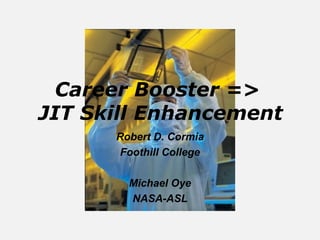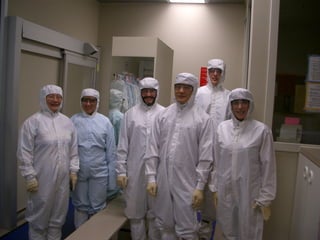Career booster – jit skilling
- 1. Career Booster => JIT Skill Enhancement Robert D. Cormia Foothill College Michael Oye NASA-ASL
- 2. Overview • Technicians in innovation economies • Two student audiences • Career preparation vs. enhancement • Just in time / rapid skilling • Putting SKILL to WORK • US competitiveness in manufacturing
- 3. Innovation Economies • Are dynamic • Industry clusters • Silicon Valley • Computation / networks • Materials engineering • Biomedical device • Clean energy technology
- 4. Innovation Economies Silicon Valley is home to innovation through the hard work of people bringing ideas, talent, and capital. In this equation, human capital is a critical factor. In Silicon Valley our innovation workforce is multidisciplinary, with foundations in science, engineering, and technology. Our skilled workforce takes decades to develop, and the talent is highly refined. When start-ups come together, the most difficult task can be finding people with strong backgrounds in bringing innovation to reality. These skills are valuable, but atrophy quickly when companies fail suddenly.
- 5. Three Problems • Underutilized physical capital – Instruments sitting idle • Underutilized human capital – People sitting idle • Problems that need to be solved – Falling behind in key industries – Energy, materials, advanced manufacturing
- 6. Putting Skill to Work • Valuable work experience – Advanced materials, instruments • Start-up / big company environments • Emerging / complex industries – Biomedical device / diagnostics – Clean energy / cleantech – Thin film coatings – Smart materials
- 8. Career Booster: 3 Stages • Stage one – LIFT OFF – College degree / BS/MS • Stage two – Career GROWTH – First two => three jobs • Stage three – REINVENTION – Transitional workforce – Dislocation => adaptation
- 9. Younger technicians rise through the ranks quickly In stage two of technical growth, new graduates pick up very specific skills and knowledge related to local innovation economies, especially industrial clusters from energy to biomedicine to semiconductors
- 10. Career Enhancement • Meeting changing demands in a company – Core technical competency evolves – Need to understand / master materials • Overcoming an existing ‘skill deficit’ – Materials knowledge / instrument skills • Transitioning into a new / related field – Clean energy bridges two disciplines: – Energy and Advanced Materials Engineering
- 11. Filling the Missing Skill Companies in high speed growth need people to acquire new skills quickly
- 12. Nanotechnology Program • Four course program to develop technicians for Silicon Valley • NANO51 – Nanotechnology Applications • NANO52 – Nanostructures / Nanomaterials • NANO53 – Nanocharacterization Tools • NANO54 – Nanofabrication Methods
- 15. Two Student Audiences • Transfer student (18-21) – Some science foundation – No industry experience • Returning student (30-55) – Science / engineering degrees – Significant industry experience Our two student audiences are completely different We have changed strategy to deliver training to our students, and reached out to transitional workers
- 17. NASA-ASL Lab Curriculum • Thin film deposition • Nanocarbon synthesis • Characterization tools – FE-SEM / TEM – AFM / SEM / XPS • Design of Experiments (DOE) • Materials safety / nanomaterials
- 18. Integrating Curriculum • Online support materials – Nanostructures – Nanocharacterization – Nanofabrication • More skill / less lecture • References for learning • Nanoscience / materials engineering
- 19. MACS Instruments • Hitachi S4800 Field Emission SEM (Scanning Electron Microscope) – Magnification to 500K x – EDX (Energy Dispersive X-Ray Analysis) • Hitachi H4500 TEM (Transmission Electron Microscope) – Magnification to 300K x – EDX (Energy Dispersive X-Ray Analysis)
- 21. Hitachi H9500 TEM High performance imaging is key to understanding nanostructures and advanced materials. The Hitachi S4500 at NASA-ASL provides students with the ability to image materials and see grain boundaries, lattice structure of thin films, and the complex nature of carbon bonding in nanocarbon structures. Through a special arrangement with NASA-ASL, we are able to provide 8-10 hours of TEM training for a students, and give them an edge on their resume, and get them ‘back in the game’.
- 22. Design of Experiments • Experimental design • Sample selection • Factorial design • Statistical analysis • Process control
- 24. Nanocarbon Synthesis • Nanodiamond treatments • Graphene / vertical graphene • Carbon Nanotubes (CNT) • Multiwall Nanotubes (MWNT) • Fullerenes and multiwall fullerenes • Carbon Nanosphere Chains (CNSC)
- 28. Initial Cohort • A dozen technical students / professionals • Six are consultants / industry connecters – One person consulting firms – IEEE working group members – Nanotech organization (Foresight) etc • Six are transitional / incumbent workers – Former technology / recently unemployed – Students transitioning back into high-tech
- 30. You are Never Too Old…
- 31. Summary • Innovation workforce – Multidisciplined • Constant reskilling / career enhancement • Valuable to innovation economy – Know how to work in start-up environments • Need to be reskilled quickly – Get people ‘back in the saddle’ quickly • Growing segment of CTE programs
- 32. References • NSF-ATE Project 0903316 • NASA-ASL Advanced Studies Lab • UCSC-MACS Materials Analysis for Collaborative Science • Hitachi Instruments • http://fgamedia/faculty/rdcormia/NANO/
































